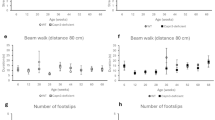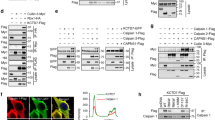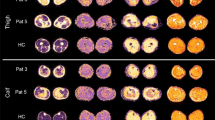Abstract
Limb girdle muscular dystrophies (LGMD) are a heterogeneous group of genetic disorders characterised by progressive weakness of the pelvic and shoulder girdle muscles and a great variability in clinical course. LGMD2A, the most prevalent form of LGMD, is caused by mutations in the calpain-3 gene (CAPN-3). More than 100 pathogenic mutations have been identified to date, however few genotype : phenotype correlation studies, including both DNA and protein analysis, have been reported. In this study we screened 26 unrelated LGMD2A Brazilian families (75 patients) through Single-Stranded Conformation Polymorphism (SSCP), Denaturing high-performance liquid chromatography (DHPLC) and sequencing of abnormal fragments which allowed the identification of 47 mutated alleles (approximately 90%). We identified two recurrent mutations (R110X and 2362-2363AG>TCATCT) and seven novel pathogenic mutations. Interestingly, 41 of the identified mutations (approximately 80%) were concentrated in only 6 exons (1, 2, 4, 5, 11 and 22), which has important implications for diagnostic purposes. Protein analysis, performed in 28 patients from 25 unrelated families showed that with exception of one patient (with normal/slight borderline reduction of calpain) all others had total or partial calpain deficiency. The effects of type of mutation, amount of calpain in the muscle, gender and ethnicity of affected patients on clinical course (age of onset and ascertainment) were analysed. Interestingly, it was observed that, on average, African–Brazilian calpainopathy patients are more severely affected than Caucasians.
Similar content being viewed by others
Log in or create a free account to read this content
Gain free access to this article, as well as selected content from this journal and more on nature.com
or
References
Zatz M, Vainzof M, Passos-Bueno MR . Limb-girdle muscular dystrophy: one gene with different phenotypes, one phenotype with different genes Curr Opin Neurol 2000 13: 511–517 (Review)
Bushby KM . The limb-girdle muscular dystrophies-multiple genes, multiple mechanisms Hum Mol Genet 1999 8: 1875–1882 (Review)
Hackman P, Richard I, Vihola A, Haravuori H, Marchand S, Labeit S, Sarparanta J, Taivainen A, Carpén O, Udd B . Tibial Muscular Dystrophy (TMD), 2q31 linked Myopathy: Sequencing and Functional Studies of the Titin (TTN) gene Journal of the Neurological Sciences 2002 199 Suppl 1: S35
Moreira ES, Wiltshire TJ, Faulkner G et al. Limb-girdle muscular dystrophy type 2G is caused by mutations in the gene encoding the sarcomeric protein telethonin Nat Genet 2000 24: 163–166
Halliday W, Greenberg CR, Wrogemann K . Genetic heterogeneity of limb girdle muscular dystrophy in Manitoba Hutterites Am J Hum Genet 1998 639 Suppl: A392 (Abstract 2280)
Passos-Bueno MR, Vainzof M, Moreira ES, Zatz M . The seven autosomal recessive limb-girdle muscular dystrophy (LGMD): from Igmd2a to Igmd2g Am J Med Genet 1999 82: 392–398
Speer MC, Vance JM, Grubber JM et al. Identification of a new autosomal dominant limb-girdle muscular dystrophy locus on chromosome 7 Am J Hum Genet 1999 64: 556–562
Starling AL, Vainzof M, Pavanello R, Canovas M, Cerqueira A, Passos-Bueno MR, Zatz M . Evidence of further genetic heterogeneity for both autosomal dominant and autosomal recessive limb-girdle muscular dystrophy Am J Hum Genet 2001 69: 1942 Suppl 1
Fanin M, Pegoraro E, Matsuda-Asada C, Brown RH, Angelini C . Calpain-3 and dysferlin protein screening in patients with limb-girdle dystrophy and myopathy Neurology 2001 1: 660–665
Beckmann JS, Richard I, Hillarie D et al. A gene for limb girdle muscular dystrophy maps to chromosome 15 by linkage C R Acad Sci Paris 1991 132: 141–148
Carafoli E, Molinari M . Calpain: a protease in search of a function? Biochem Biophys Res Commun 1998 247: 193–203 (Review 18)
Ono Y, Sorimachi H, Suzuki K . Structure and physiology of calpain, an enigmatic protease Biochem Biophys Res Commun 1998 245: 289–294 (Review 17)
Suzuki K, Sorimachi H . A novel aspect of calpain activation FEBS Lett 1998 433: 1–4 (Review 14)
Sorimachi H, Ono Y, Suzuki K . Skeletal muscle-specific calpain, p94, and connectin/titin: their physiological functions and relationship to limb-girdle muscular dystrophy type 2A Adv Exp Med Biol 2000 481: 383–395 (discussion); 395–397, (Review)
Baghdiguian S, Martin M, Richard I et al. Calpain 3 deficiency is associated with myonuclear apoptosis and profound perturbation of the IkappaB alpha/NF-kappaB pathway in limb-girdle muscular dystrophy type 2A Nat Med 1999 5: 503–511
Richard I, Roudaut C, Saenz A et al. Calpainopathy–a survey of mutations and polymorphisms Am J Hum Genet 1999 64: 1524–1540
Chae J, Minami N, Jin Y, Nakagawa M, Murayama K, Igarashi F, Nonaka I . Calpain 3 gene mutations: genetic and clinico-pathologic findings in limb-girdle muscular dystrophy Neuromuscul Disord 2001 11: 547–555
Bushby KM, Beckmann JS . The limb-girdle muscular dystrophies–proposal for a new nomenclature Neuromuscul Disord 1995 5: 337–343
Azevedo ES . Subgroup studies of back admixture within a mixed population of Bahia, Brazil Ann Hum Genet 1980 44: 55–60
Anderson LV, Davison K, Moss JA et al. Characterization of monoclonal antibodies to calpain 3 and protein expression in muscle from patients with limb-girdle muscular dystrophy type 2A Am J Pathol 1998 153: 1169–1179
Vainzof M, Anderson LV, McNally EM et al. Dysferlin protein analysis in limb-girdle muscular dystrophies J Mol Neurosci 2001 17: 71–80
Pogue R, Anderson LV, Pyle A et al. Strategy for mutation analysis in the autosomal recessive limb-girdle muscular dystrophies Neuromuscul Disord 2001 11: 80–87
Miller SA, Dykes DD, Polesky HF . A Yesple salting out procedure for extracting DNA from human nucleated cells Nucleic Acids Res 1988 16: 1215
Richard I, Broux O, Allamand V et al. Mutations in the proteolytic enzyme calpain 3 cause limb-girdle muscular dystrophy type 2A Cell 1995 81: 27–40
Allamand V, Broux O, Richard I et al. Preferential localization of the limb-girdle muscular dystrophy type 2A gene in the proximal part of a 1-cM 15q15.1-q15.3 interval Am J Hum Genet 1995 56: 1417–1430
Weber JL, May PE . Abundant class of human DNA polymorphisms which can be typed using the polymerase chain reaction Am J Hum Genet 1989 44: 388–396
Welch BL . On the comparison of several mean values: an alternative approach Biometrika 1951 38: 330–336
Urtasun M, Saenz A, Roudaut C et al. Limb-girdle muscular dystrophy in Guipuzcoa (Basque Country, Spain) Brain 1998 121: 1735–1747
Fardeau M, Eymard B, Mignard C, Tome FM, Richard I, Beckmann JS . Chromosome 15-linked limb-girdle muscular dystrophy: clinical phenotypes in Reunion Island and French metropolitan communities Neuromuscul Disord 1996 6: 447–453
Richard I, Brenguier L, Dincer P et al. Multiple independent molecular etiology for limb-girdle muscular dystrophy type 2A patients from various geographical origins Am J Hum Genet 1997 60: 1128–1138
Zatz M, Vainzof M, Passos-Bueno MR (ed). Serum Creatine-Kinase (CK) In progressive Muscular Dystrophy in Bushby KMD, Anderson LVB (ed) Totowa, New Jersey: Human Press 2001 pp 31–49
Passos-Bueno MR, Rabbi-Bortolini ER, Azevedo E, Zatz M . Racial effect on serum creatine-kinase for females at-risk for Duchenne dystrophy Clin Chim Acta 1989 179: 153–168
van der Maarel SM, Deidda G, Lemmers RJLF et al. De novo facioscapulohumeral muscular dystrophy: Frequent somatic mosaicism, sex-dependent phenotype, and the role of mitotic transchromosomal repeat interaction between chromosomes 4 and 10 Am J Hum Genet 2000 66: 26–35
Zatz M, Marie SK, Cerqueira A, Vainzof M, Pavanello RC, Passos-Bueno MR . The facioscapulohumeral muscular dystrophy (FSHD1) gene affects males more severely and more frequently than females Am J Med Genet 1998 77: 155–161
Pollitt C, Anderson LV, Pogue R, Davison K, Pyle A, Bushby KM . The phenotype of calpainopathy: diagnosis based on a multidisciplinary approach Neuromuscul Disord 2001 11: 287–296
Acknowledgements
The collaboration of the following persons is gratefully acknowledged: Anita Kai, Rita Viegas, Tatiana Jazedje, Alessandra Splendore, Kikue Abe, Agnes Nishimura, Andrea Bernardino, Manuela Toninni, Carlos Maranduba, Eloisa de Sá Moreira for their scientific help and to Constância Urbani, Antônia Cerqueira and Marta Canovas for their secretarial and technical help. We would like to thank ABDIM and the affected families that collaborated with this research. This work was supported by FAPESP/CEPID, PRONEX, CNPq, IAEA. V Nigro is recipient of grants from Telethon (Italy) and MIUR (P.R.I.N.).
Author information
Authors and Affiliations
Corresponding author
Rights and permissions
About this article
Cite this article
de Paula, F., Vainzof, M., Passos-Bueno, M. et al. Clinical variability in calpainopathy: What makes the difference?. Eur J Hum Genet 10, 825–832 (2002). https://doi.org/10.1038/sj.ejhg.5200888
Received:
Revised:
Accepted:
Published:
Issue date:
DOI: https://doi.org/10.1038/sj.ejhg.5200888
Keywords
This article is cited by
-
Genetic modifiers and phenotypic variability in neuromuscular disorders
Journal of Applied Genetics (2020)
-
European muscle MRI study in limb girdle muscular dystrophy type R1/2A (LGMDR1/LGMD2A)
Journal of Neurology (2020)
-
Novel Missense CAPN3 Mutation Responsible for Adult-Onset Limb Girdle Muscular Dystrophy with Calves Hypertrophy
Journal of Molecular Neuroscience (2019)
-
Pericytes Extend Survival of ALS SOD1 Mice and Induce the Expression of Antioxidant Enzymes in the Murine Model and in IPSCs Derived Neuronal Cells from an ALS Patient
Stem Cell Reviews and Reports (2017)
-
Linkage Study Revealed Complex Haplotypes in a Multifamily due to Different Mutations in CAPN3 Gene in an Iranian Ethnic Group
Journal of Molecular Neuroscience (2016)



